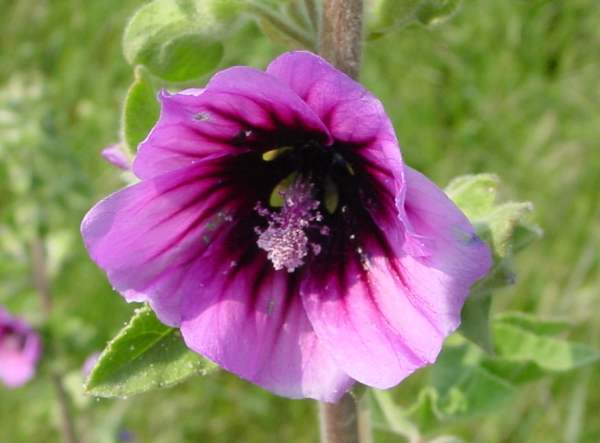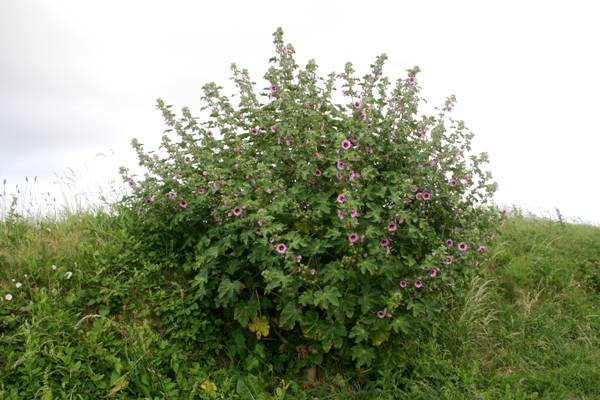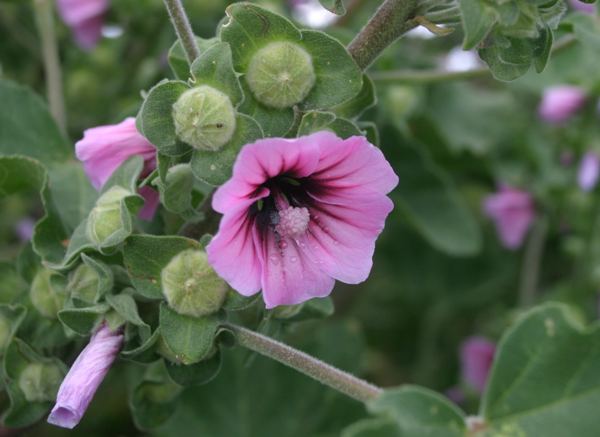Trees Birds Mammals Fish Amphibians Reptiles
Wild Algarve
Bookshop
Malva arborea - Tree Mallow
Phylum: Magnoliophyta - Class: Equisetopsida - Order: Malvales - Family: Malvaceae

There are many kinds of mallows in Britain and Ireland, including several garden escapes. Mallows are usually low-growing plants, but Tree Mallow is an exception: this species can occasionally attain a height of three metres. Also known as Bush Mallow and Velvet Tree-mallow, until recently this plant was referred to by the scientific name Lavatera arborea.

Description
Tree Mallow can be an annual or a biennial, but in more sheltered locations it is a perennial. Unfortunately, the stems crack easily and so plants in windy sites tend to suffer wind throw because in the wild they rarely have a stronger species to grow against as a windbreak.

Above: Tree Mallow beside the Conwy Estuary
Malva arborea has alternate, palmate velvety leaves each with five to nine lobes. The flowers, which are borne in clusters of two or more in the leaf axils, are 3 to 4cm across and have five bright pink-purple petals with darker purple veins.

Distribution
In Britain and Ireland this species is most common in the south, while its distribution in Scotland is entirely coastal and mainly confined to the south and east, although it is now reported to be spreading on some Scottish coastal islands, maybe transported by birds but quite possibly via seeds carried there on coastal currents - the seeds are protected by a waterproof outer casing and so are protected from the salty water.
Native to Western and southern Europe and northwest Africa, Tree Mallow has been introduced to many other regions including Australia, Chile, Argentina and some parts of southwest USA.
Habitat
Tree Mallow favours nutrient-rich dry sandy soils and can cope with quite high levels of salinity. In Britain and Ireland this mallow species is only occasionally found far from the coast (save for garden plants and garden escapes) because it cannot cope with frost.

Blooming times
In Britain and Ireland Tree Mallow produces its flowers from late May until September.
Etymology
The common name and the specific epithet both refer to the tree-like stature of this wildflower.
Uses
Tree Mallow is often seen in parks and gardens. The leaves have long been used by herbalists as a poultice to treat sprains; and at one time this plant was also used as cattle fodder.
Sue Parker's latest ebook is a revised and enlarged edition of Wild Orchids in The Burren. Full details here...
Buy it for just £5.95 on Amazon...
Sue Parker's new ebook is a comprehensive and fully revised edition of her acclaimed field guide to the Wild Orchids of Wales. Full details here...
Buy it for just £5.95 on Amazon...
Please Help Us: If you have found this information interesting and useful, please consider helping to keep First Nature online by making a small donation towards the web hosting and internet costs.
Any donations over and above the essential running costs will help support the conservation work of Plantlife, the Rivers Trust and charitable botanic gardens - as do author royalties and publisher proceeds from books by Pat and Sue.